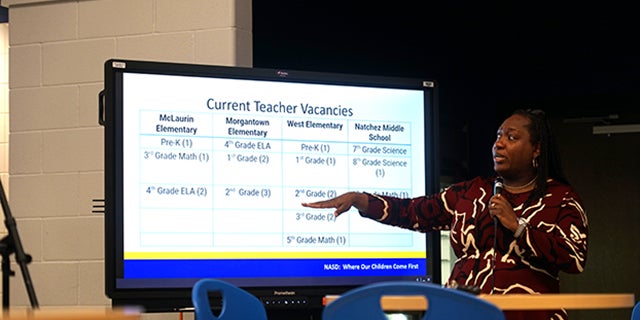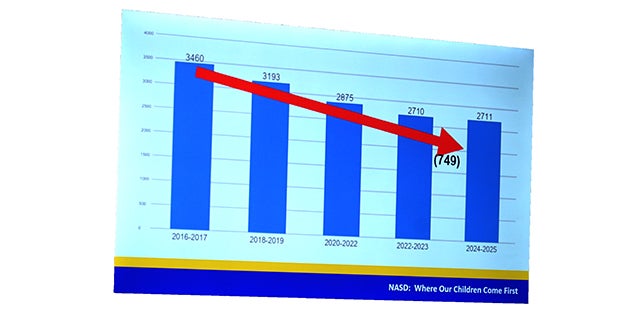SHRINKING PAINS: Natchez Adams School District facing teacher shortages, declining enrollment
Published 11:05 am Monday, April 15, 2024

- Interim Superintendent Zandra McDonald-Green describes the teacher shortage to stakeholders at "My Voice, My NASD Community Conversations" last week. (Sabrina Robertson | The Natchez Democrat)
|
Getting your Trinity Audio player ready...
|
NATCHEZ — The Natchez Adams School District is battling a number of challenges from teacher shortages to declining enrollment, as well as budget and funding concerns.
The next fiscal budget will be significantly smaller than the last as federal money that has kept programs in place the last three years comes to an end.
Combine that with hundreds of students who have not returned to the district since the COVID-19 pandemic, and the district must find ways to make up for the shortfalls that will surely come.
Teacher shortage
Perhaps one of the biggest shortfalls the district has is a lack of certified teachers.
NASD Interim Superintendent Zandra McDonald-Green said like other districts nationwide, NASD is experiencing the effects of a teacher shortage. As seen by the reorganization plan presented this week, the district seeks to stem losses by cutting positions and moving staff and students around.
The district currently has eight permanent substitutes, teachers who are not certified by state standards, and 17 teacher vacancies for the upcoming school year, which is subject to change closer to August, Green said. At this time last year, NASD had 26 vacancies, she said.
Green said she “could not anticipate” how many teachers may leave for other school districts that have higher paying salaries or fewer workdays each week.
Population decline

This graph provided by Natchez Adams School District shows the declining student population.
The district is currently funded on average approximately $14,200 per student from local, state and federal sources, which is up from approximately $11,400 prior to the COVID-19 pandemic.
Since 2016, Natchez Adams School District has seen a gradual annual loss enrollment, from 3,460 students enrolled during the 2016-2017 school year to 2,711 students enrolled for the 2024-2025 school year.
Green said 750-student decline coincides with a declining population. Green said some students “never returned” after schools transitioned to virtual instruction during the COVID-19 pandemic.
Those numbers are expected to continue dropping with the opening of a new charter school Instant Impact Global Prep, which didn’t affect the district much this school year as the charter school mostly pulled students who were being homeschooled previously or attending private schools, Green said. However, the charter school will continue to add a grade level each year and likely will pull in NASD students and state funds, she said.
“They estimated they would enroll 150 students a year,” Green said. “We are anticipating further decline as they enroll a new grade level each year.”
Why population matters
The school district receives state funding allocations that are decided on by legislators based on a number of factors, the main one being average daily attendance.
“The school district may have 2,800 students enrolled during the school year, but if on average only 2,400 of those students show up then we’re only going to be funded based on the 2,400 who show up,” Green said. “That is why it is very important that your children are at school. If student enrollment decreases, that affects our allocation.”
The latest chronic absenteeism report from the Mississippi Department of Education based on the 2022-2023 academic year’s numbers, Natchez Adams School District had a chronic absenteeism rate of 18.44%. Students who are chronically absent miss 10% or more — 18 days of school — per year or roughly two days for each month of school, according to MDE.
When enrollment is down, the district can request funding based on the previous year’s attendance and the district would see the loss of those funds the following school year, Green said.
ESSER grant expires
Despite population decline, the budget has been inflated, almost double what it was in prior years thanks to the Elementary and Secondary School Emergency Relief (ESSER) Fund created by the 2021 CARES Act.
These funds could only be expended following stringent federal requirements.
During the 2023-2024 budget cycle, the district is operating with an $80.3 million budget. The prior cycle that budget was $71,1 million.
ESSER was allocated in three phases.
The Natchez Adams School District had been allocated $2,418,586 from ESSER I grants, which ended Sept. 30, 2022; $9,791,941 from ESSER II grants which ended Sept. 30, 2023, and $21,991,309 from ESSER III which ends Sept. 30, 2024.
Much of these funds were expended on Chromebooks, WiFi devices and virtual classroom programs during the pandemic such as Canvas; touchless restroom and air filtration systems; and several programs to mitigate learning loss from the COVID-19 pandemic, such as afterschool tutoring, fall and spring intercessions and summer programs, Green said.
“As of Sept. 30, 2024 — in a few months — that money is done. There is no more COVID funding that we are aware of coming to the district. If we have not spent all of it, it goes back to the federal government. We’re doing everything we possibly can to make sure we’re not sending back any funding because we understand the impact that funding has on our district,” she said. “The additional services that we had been able to provide students to address learning loss, we are now going to have to turn to other funding sources to fund those initiatives.”
Local funding sources
Approximately one-third of the school district’s funds come from local contributions, which are generated by ad valorem taxes. Every Adams County property owner, with or without children, pays these taxes to the school district.
Green said the district has not increased its funding request in four years. Their requested tax contribution is made to the Adams County Board of Supervisors in dollars which the county then converts to mills. In the past four years, this dollar request has been approximately $14.2 million. However, the district did not always receive that amount.
“In past narratives, it has been said that the district has been in the business of raising your taxes,” Green said. “As a district, we have asked for the same amount of money from the county for the last four years despite inflation. … While our expenses have gone up, we’ve been operating at the same level.”
What is being done differently
The 2024-2025 academic school year calendar approved by the school board includes a spring intersession but not a fall intersession, where only select students report to school.
“The reason for that is lack of participation,” Green said. “We didn’t see as strong numbers participating in intersessions last school year as we had at the beginning.”
The cost of intersessions ranged from $89,000 to $125,000, which includes the personnel, transportation and resources. The federal government also provides Title I funds based on special populations, such as students living in poverty.
“While the budget is changing, our plan is to continue offering afterschool tutoring with the federal allocations that we have,” Green said.





